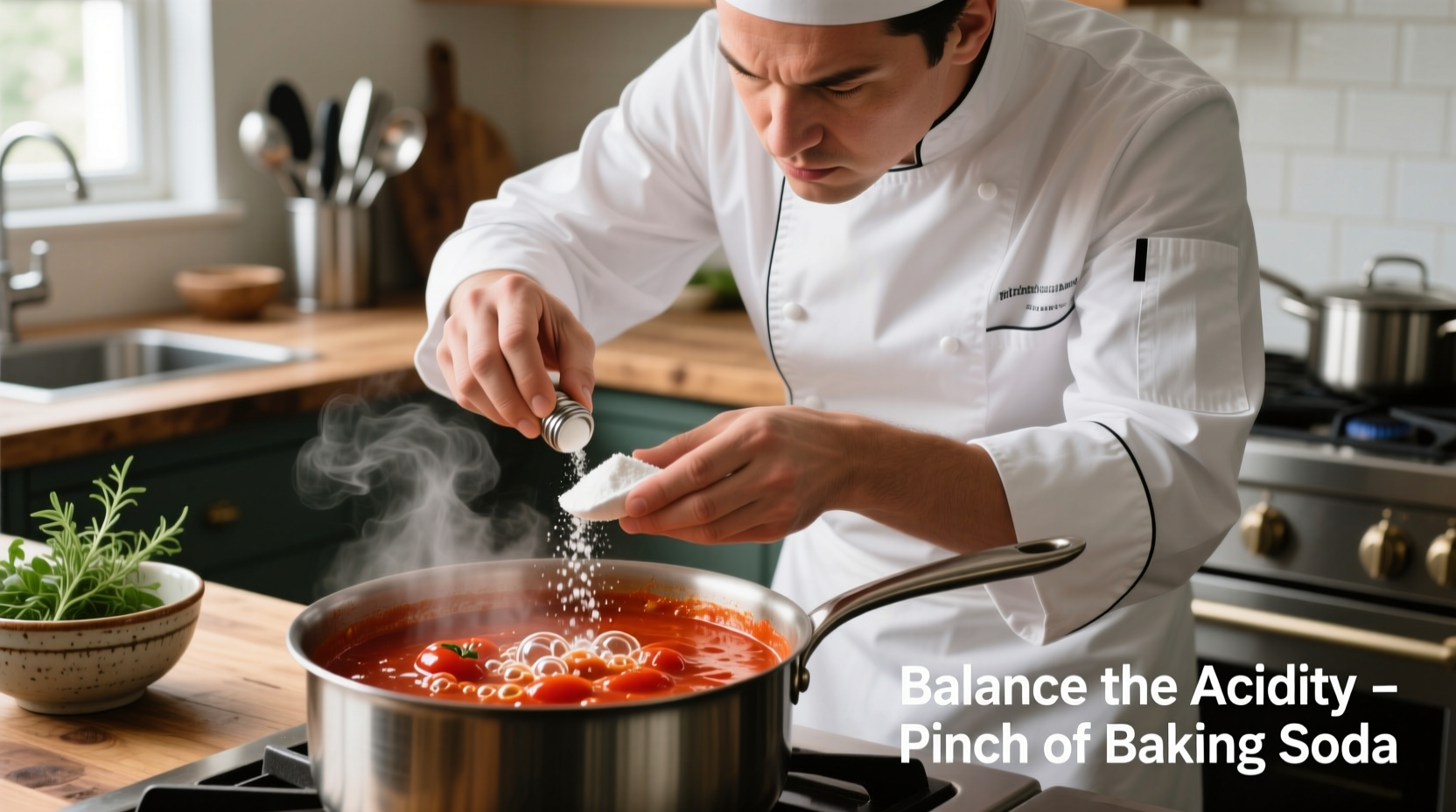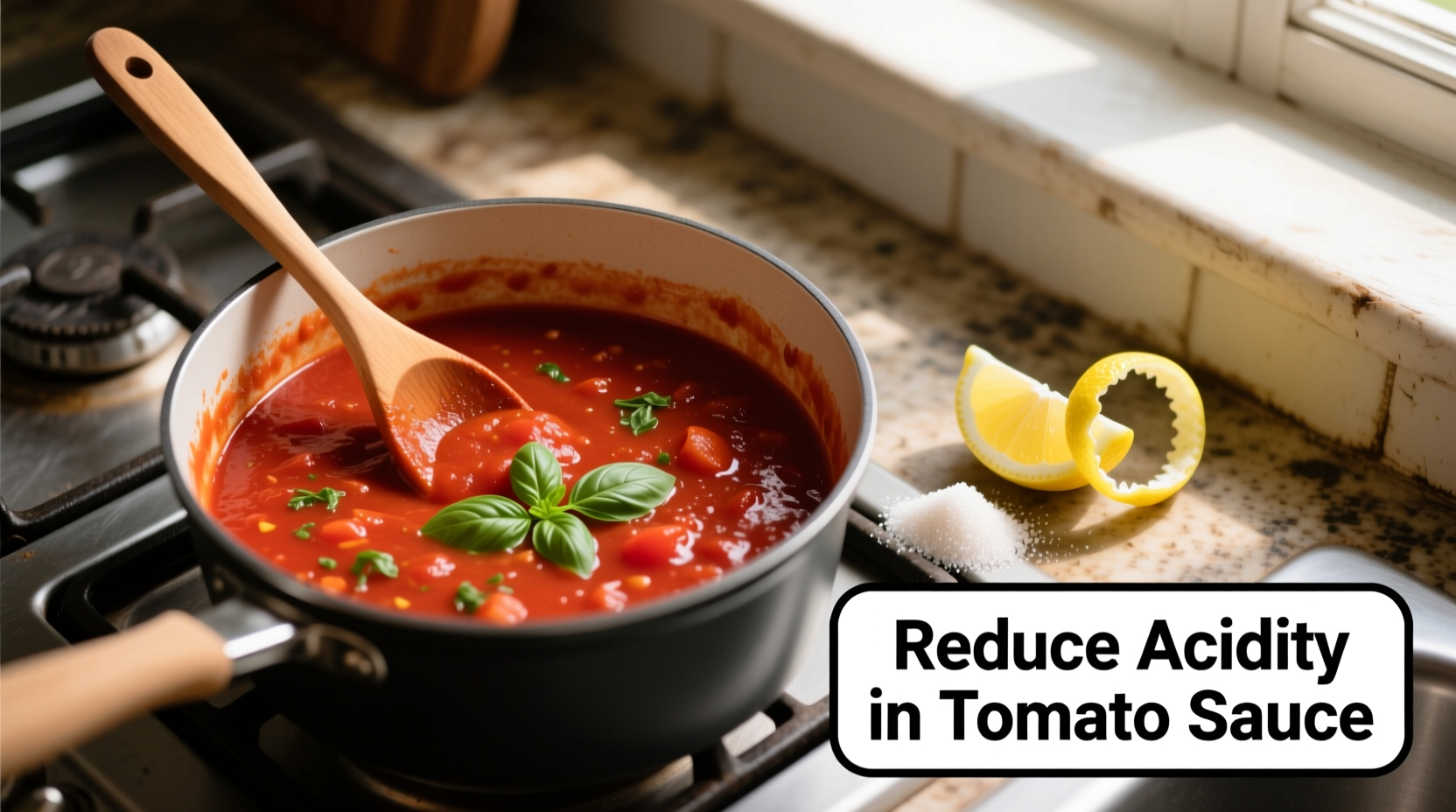The most effective way to reduce acidity in tomato sauce is by adding a small amount of baking soda (1/8 teaspoon per cup of sauce), which neutralizes acid through a chemical reaction. Alternatively, simmering with grated carrots, a pinch of sugar, or a Parmesan rind balances acidity naturally without altering flavor significantly. Always add these ingredients gradually while tasting to avoid overcorrection.
Tomato sauce that bites back with excessive tartness can ruin an otherwise perfect pasta dish. As a professional chef who's spent years mastering Italian cuisine, I've helped countless home cooks transform their acidic tomato sauces into perfectly balanced creations. The good news? Fixing overly acidic tomato sauce is simpler than you think—and you likely have everything you need in your pantry right now.
Why Tomato Sauce Becomes Too Acidic
Tomatoes naturally contain citric and malic acids, with pH levels typically ranging from 4.3 to 4.9. Several factors can intensify this acidity:
- Tomato variety - Canned San Marzano tomatoes generally have lower acidity than standard Roma varieties
- Processing method - Peeled and seeded tomatoes often concentrate acids
- Cooking duration - Extended simmering can intensify perceived acidity
- Added ingredients - Wine or vinegar can compound acidity issues
According to USDA food composition data, the natural pH of tomatoes varies significantly based on ripeness and growing conditions. Fully ripe tomatoes generally have lower acidity than underripe ones, which explains why "out of season" tomatoes often produce more acidic sauces.
7 Proven Methods to Reduce Acidity in Tomato Sauce
1. Baking Soda: The Quick Chemical Solution
When you need immediate results, baking soda (sodium bicarbonate) works through a simple acid-base reaction. This method is particularly effective for last-minute corrections:
- Start with 1/8 teaspoon per cup of sauce
- Mix thoroughly and wait 30 seconds for the reaction to complete
- Taste and repeat if necessary (never exceed 1/4 teaspoon per cup)
Important note: Overuse creates a soapy flavor and can cause foaming. The FDA's food pH database confirms that even small amounts of baking soda can raise pH levels significantly.
2. Natural Sweeteners: Carrots and Onions
For a more gradual approach that enhances flavor complexity, natural sweeteners work beautifully:
| Natural Sweetener | Amount per 4 Cups Sauce | Simmer Time | Flavor Benefit |
|---|---|---|---|
| Finely grated carrots | 1 medium carrot | 20-30 minutes | Adds subtle sweetness without sugar taste |
| Caramelized onions | 1/2 cup finely diced | 15-20 minutes | Creates rich umami depth |
| Fennel bulb | 1/4 cup finely diced | 25-35 minutes | Complements tomato flavor profile |
Food science research from the USDA National Institute of Food and Agriculture shows that the natural sugars in these vegetables undergo caramelization during cooking, which counteracts acidity perception without adding sweetness.
3. Dairy Products: Cream and Cheese
Dairy contains casein proteins that bind with acids, creating a smoother mouthfeel:
- Parmesan rind - Simmer a 2" x 2" piece in 4 cups sauce for 20 minutes
- Heavy cream - Add 1-2 tablespoons at the end of cooking
- Ricotta - Stir in 1/4 cup for baked pasta dishes
This method works particularly well for creamy tomato sauces like those used in vodka sauce recipes. The University of California's Department of Food Science notes that dairy proteins effectively buffer acidity while adding richness.

4. Sugar: The Controlled Approach
While controversial among purists, sugar remains a reliable acidity reducer when used judiciously:
- Start with 1/2 teaspoon per 4 cups of sauce
- Use granulated sugar for quick dissolution
- Consider honey or maple syrup for more complex flavor profiles
Professional chefs at the Culinary Institute of America recommend combining sugar with a pinch of salt to enhance its balancing effect without making the sauce taste sweet.
5. Wine Reduction Technique
Counterintuitively, properly used wine can reduce perceived acidity:
- Add 1/4 cup dry red wine to the sauce
- Simmer uncovered for 10-15 minutes to evaporate alcohol
- The alcohol extraction pulls out flavor compounds that balance acidity
This technique works because the alcohol in wine extracts flavor compounds from tomatoes that aren't soluble in water alone, creating a more rounded flavor profile according to research published in the Journal of Food Chemistry.
6. Cooking Time and Temperature Control
How you cook your sauce significantly impacts acidity perception:
- Low and slow - Simmer at 180-200°F for 2-3 hours develops natural sweetness
- Avoid high heat - Boiling concentrates acids and creates bitter compounds
- Cover partially - Allows some evaporation without concentrating acids
Temperature control is crucial—exceeding 212°F (100°C) causes tomatoes to release more citric acid, worsening the problem you're trying to fix.
7. Herb and Spice Balancing Act
Certain herbs and spices create flavor illusions that mask acidity:
- Basil - Adds sweet notes that counteract tartness
- Oregano - Earthy flavor balances bright acidity
- Red pepper flakes - Distracts taste buds from acidity perception
- Bay leaves - Adds subtle bitterness that rounds out flavor
According to flavor chemistry studies, these herbs contain compounds that interact with taste receptors to create a perception of balance, even when pH levels remain unchanged.
Common Mistakes That Worsen Acidity Problems
Avoid these pitfalls when trying to reduce acidity:
- Adding baking soda all at once - Causes foaming and soapy flavor
- Using aluminum cookware - Reacts with acids creating metallic tastes
- Adding sugar without tasting - Creates cloying sweetness
- Over-reducing sauce - Concentrates remaining acids
Troubleshooting Your Acidic Tomato Sauce
If Your Sauce Is Still Too Acidic
Try these emergency fixes:
- Add a small potato (1/4 cup diced) and simmer for 15 minutes—potatoes absorb excess acid
- Stir in 1 tablespoon of mascarpone cheese for immediate smoothing effect
- Dilute with a small amount of low-acid tomato passata
If You've Overcorrected and Sauce Tastes Flat
Restore balance with:
- A splash of red wine vinegar (yes, more acid can fix overcorrection)
- Additional salt to enhance remaining flavor compounds
- Fresh herbs added at the very end of cooking
Preventing Acidic Tomato Sauce in Future
Professional chefs recommend these preventative measures:
- Choose San Marzano DOP tomatoes—they have naturally lower acidity
- Add a pinch of baking soda to the cooking water when preparing fresh tomatoes
- Always include a small amount of natural sweetener from the start
- Use ripe, in-season tomatoes when possible
Remember that acidity isn't inherently bad—tomato sauce needs some acidity for brightness. The goal is balance, not elimination. As the America's Test Kitchen research team discovered through extensive testing, the ideal tomato sauce has a pH between 4.6 and 4.9 for optimal flavor development.











 浙公网安备
33010002000092号
浙公网安备
33010002000092号 浙B2-20120091-4
浙B2-20120091-4